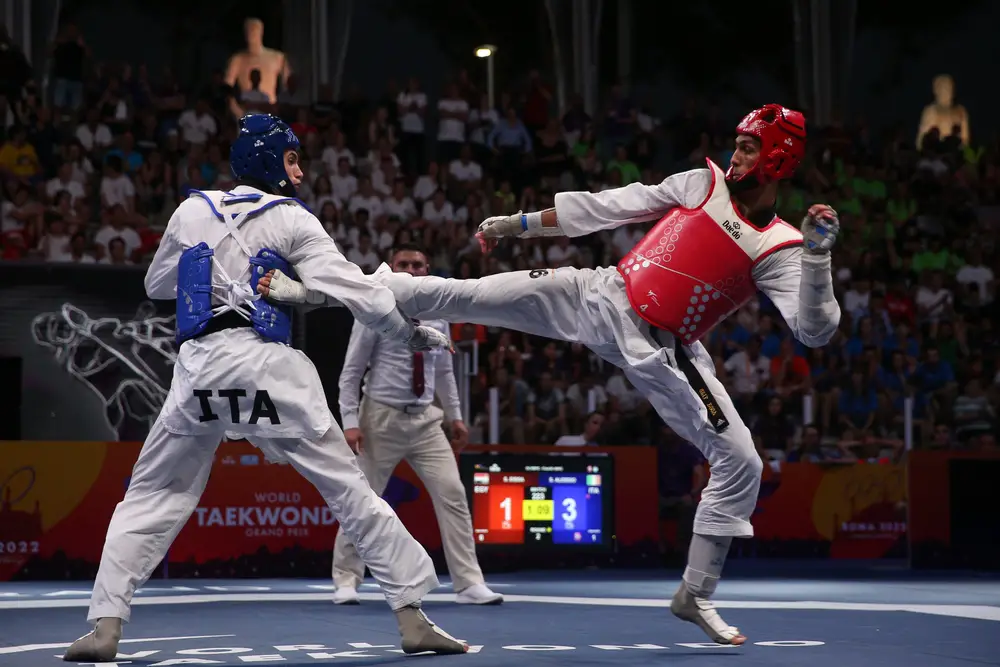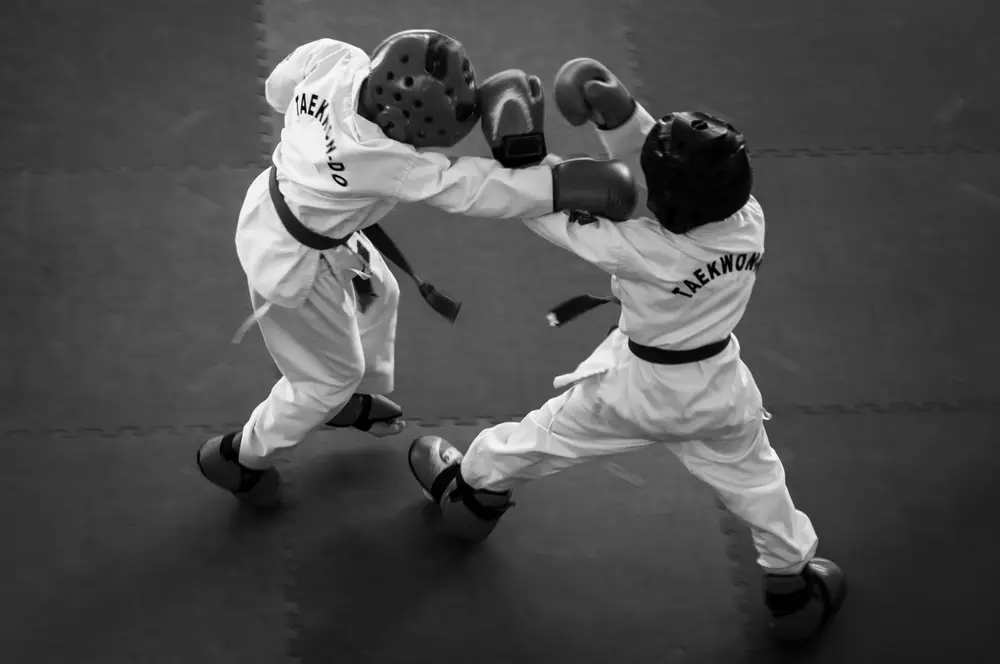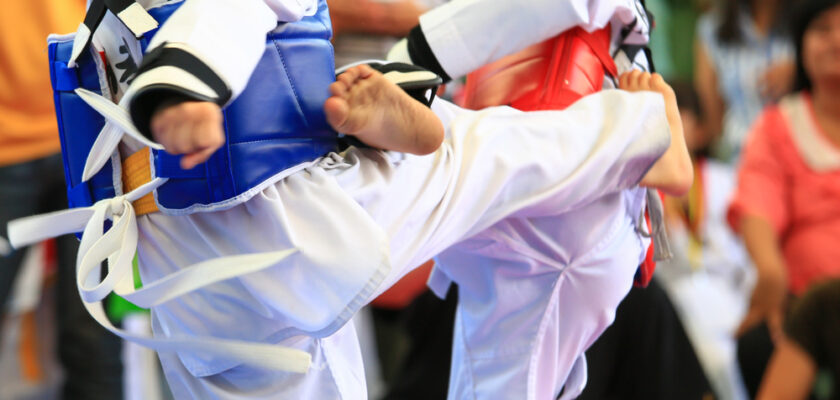Taekwondo is a Korean martial art practiced around the world. It is not only a competitive sport, but also a form of personal development and self-defense full of teachings. The sport is known for its high and fast kicks, as well as its philosophy.
The sport is known for seeking to promote self-discipline, respect and integrity. Rooted in Korean culture and tradition, it also has a number of specific terms that are fundamental to practicing and understanding this martial art.

With this in mind, we have created the taekwondo glossary, with the main terms used in the sport. Check it out!
Open your Betano account and get up to 1,000 reais in bonuses.
Payments via PIX, live games and super odds!
Click here to open your account!
Taekwondo glossary: complete list
- Ap Chagi
- Bandae Dollyo Chagi
- Bandal Chagi
- Baro
- Charyot
- Chagi
- Dan
- Deung Jumeok
- Dojang
- Dwit Chagi
- Gyeorugi
- Hogu
- Hosinsul
- Ilbo Daeryeon
- Jireugi
- Juchum Seogi
- Kihap
- Kyorugi
- Makgi
- Momtong
- Poomsae
- Seogi
- Sijak
- Sine Wave
- Sonbadak
- taekwondoin
- Tul
- Yeop Chagi
- Yop Jumeok
- Yop Seogi
- Zenkutsu Dachi
Taekwondo glossary: learn more about the terms
Ap Chagi
Ap Chagi is a front kick executed with the front of the foot. It is one of the most basic and important techniques in taekwondo, used both in combat and in form training (Poomsae). Precision and speed are crucial to the effectiveness of this kick.
Bandae Dollyo Chagi
Bandae Dollyo Chagi is the reverse spin kick. Performed with the back leg, it involves a rotation of the body, adding power and speed to the movement. It is an advanced technique, often used in competitions due to its potential impact.
Bandal Chagi
Bandal Chagi is the arch kick. Performed with the top of the foot, it is usually aimed at the opponent’s midriff. It is used both in combat and in demonstrations, and stands out for its speed and precision.
Baro
The term baro means “right” or “correct”. In the context of taekwondo, it is used to indicate a correct posture or movement. It is also a command used by instructors to guide students to adjust their postures.
Charyot
Charyot is the position of attention. When the instructor says “Charyot”, the practitioners should stand up straight, with their feet together and their arms at their sides, as a sign of respect and readiness.
Chagi
Chagi is a generic term for “kicking”. It includes a variety of kicking techniques, each with its own specific form and application. Chagi is a central component of taekwondo training.
Dan
Dan means a level of rank in taekwondo, indicating the degree of experience and skill of a practitioner. Dan grades range from 1st Dan (beginner black belt) to 9th Dan, reserved for high-level masters.
Deung Jumeok
Deung Jumeok is the name given to the back of the fist. In some attack techniques, this part of the hand is used to strike the opponent, taking advantage of its bone structure to cause impact.
Dojang
Dojang is the term used to designate the taekwondo training ground. This space is sacred to practitioners and must be kept clean and organized, reflecting respect for the martial art.
Dwit Chagi
Dwit Chagi is the back kick. Performed with the heel, it is powerful and can be used both in defense and attack, hitting the opponent behind the practitioner.
Gyeorugi
Gyeorugi is taekwondo sparring or combat. It can be practiced as a sporting competition or as training between partners.
Hogu
Hogu is the protector used during taekwondo competitions to protect the torso of practitioners. This equipment is essential for the athletes’ safety, allowing them to deliver powerful blows without causing serious injury.
Hosinsul
Hosinsul are the self-defense techniques in taekwondo. It includes a variety of techniques that allow the practitioner to defend themselves against attacks and dangerous situations.
Ilbo Daeryeon
Ilbo Daeryeon is step-by-step combat. This form of training is used to practice the application of attack and defense techniques in a controlled and sequential manner.
Jireugi
Jireugi is the term for punching. It includes various punching techniques, each adapted to different situations and targets. The basic punch, or Jireugi, is fundamental in the taekwondo arsenal.
Juchum Seogi
Juchum Seogi is the horse stance, a low, stable posture used in the execution of attack and defense techniques. It is one of the basic stances in taekwondo.
Kihap
Kihap is the cry that fighters emit when executing attack or defense techniques. This shout helps to concentrate energy, increase the power of the blow and intimidate the opponent.
Kyorugi
Kyorugi is another term for combat, often used interchangeably with Gyeorugi.
Makgi
Makgi is the name given to blocking techniques. They are essential for defending yourself against your opponent’s counterattacks, deflecting or absorbing the impact of blows.
Momtong
Momtong is the area of the fighter’s torso. In other words, it refers to blows or defenses aimed at this part of the body, which includes the chest and abdomen.
Poomsae
Poomsae are the forms or sequences of movements in taekwondo. Each Poomsae consists of a series of attack and defense techniques performed in a specific pattern, simulating combat against multiple opponents.
Seogi
Seogi is the name given to stances in taekwondo. There are several stances, each suited to different techniques and situations. The correct posture is fundamental to the effectiveness of the techniques.
Sijak
Sijak is the command to start. Used by instructors to start an exercise, a fight or a form practice, it marks the beginning of the action.
Sine Wave
Sine Wave is a wave-like movement used in some taekwondo techniques, especially in the ITF school. This movement helps to generate more power in the blows, always using the natural movement of the body.
Sonbadak
Sonbadak is the fighter’s palm. In some defense and attack techniques, the palm is used to strike or deflect the opponent’s attacks.
taekwondoin
A taekwondoin is a practitioner of taekwondo. The term is used to classify those who train and follow the principles of the martial art.
Tul
Tul are the forms or patterns practiced in the ITF style of taekwondo. Each Tul consists of a series of movements that represent combat against one or more imaginary opponents.
Yeop Chagi
Yeop Chagi is the side kick executed with the blade of the foot, usually aimed at the opponent’s torso or head, and is a powerful and versatile technique.
Yop Jumeok
Yop Jumeok is the side punch, performed with the side of the fist. It is a technique used in specific combat situations, delivering a strong, direct blow.
Yop Seogi
Yop Seogi is the side stance used to prepare for side kick techniques or to defend against attacks from specific sides.
Zenkutsu Dachi
Zenkutsu Dachi is the frontal position used to generate strength and stability during the execution of attack and defense techniques.

Taekwondo glossary: complete list
- Ap Chagi
- Bandae Dollyo Chagi
- Bandal Chagi
- Baro
- Charyot
- Chagi
- Dan
- Deung Jumeok
- Dojang
- Dwit Chagi
- Gyeorugi
- Hogu
- Hosinsul
- Ilbo Daeryeon
- Jireugi
- Juchum Seogi
- Kihap
- Kyorugi
- Makgi
- Momtong
- Poomsae
- Seogi
- Sijak
- Sine Wave
- Sonbadak
- Taekwondoin
- Tul
- Yeop Chagi
- Yop Jumeok
- Yop Seogi
- Zenkutsu Dachi
If you enjoyed learning about the taekwondo glossary, take advantage of the fact that you’ve come this far and check out our other articles on the martial art and many other sports.
Don’t forget to leave a comment telling us what you thought of the article and what else you’d like to read here!



